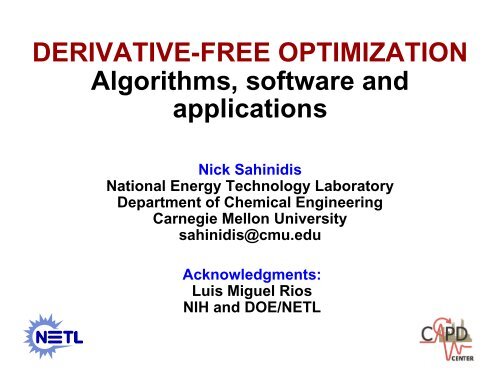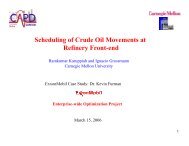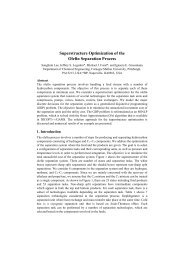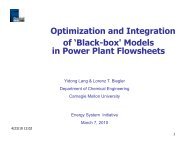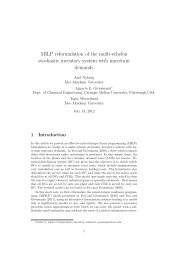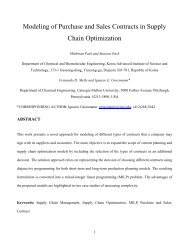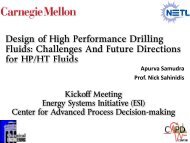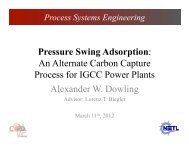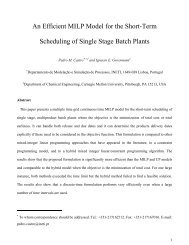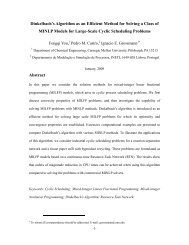DERIVATIVE-FREE OPTIMIZATION Algorithms, software and ...
DERIVATIVE-FREE OPTIMIZATION Algorithms, software and ...
DERIVATIVE-FREE OPTIMIZATION Algorithms, software and ...
Create successful ePaper yourself
Turn your PDF publications into a flip-book with our unique Google optimized e-Paper software.
<strong>DERIVATIVE</strong>-<strong>FREE</strong> <strong>OPTIMIZATION</strong><br />
<strong>Algorithms</strong>, <strong>software</strong> <strong>and</strong><br />
applications<br />
Nick Sahinidis<br />
National Energy Technology Laboratory<br />
Department of Chemical Engineering<br />
Carnegie Mellon University<br />
sahinidis@cmu.edu<br />
Acknowledgments:<br />
Luis Miguel Rios<br />
NIH <strong>and</strong> DOE/NETL<br />
1
<strong>DERIVATIVE</strong>-<strong>FREE</strong><br />
<strong>OPTIMIZATION</strong><br />
• Optimization of a function for which<br />
– derivative information is not symbolically available<br />
– derivative information is not numerically computable<br />
• Talk outline<br />
– Motivation<br />
– Review of algorithms <strong>and</strong> <strong>software</strong><br />
– Application to protein-lig<strong>and</strong> binding<br />
– Two new algorithms<br />
2
MODEL CALIBRATION<br />
(Maguthan <strong>and</strong> Shoemaker, 2005)<br />
Cl Cl<br />
Cl C C Cl<br />
Tetrachloroethene<br />
H H<br />
Dechlorination 1<br />
Dechlorination 2<br />
H Cl<br />
Cl C C Cl<br />
Trichloroethene<br />
Cl C C Cl<br />
cis-1,2-Dichloroethene<br />
H H<br />
C C<br />
H H<br />
Ethene<br />
Dechlorination 3<br />
Dechlorination 4<br />
H<br />
Cl C C<br />
H<br />
H<br />
Vinyl Chloride<br />
Parameter estimation problem on top of PDEs<br />
Each function evaluation takes 2.5 hours<br />
3
APPLICATIONS<br />
• Parameter estimation over differential<br />
equations<br />
• Optimal control problems<br />
• Simulation-based optimization<br />
– Objective computation may involve sampling<br />
• Automatic calibration of optimization<br />
algorithms<br />
• Experimental design/optimization<br />
4
TIMELINE OF INNOVATION<br />
5
MOST CITED WORKS<br />
6
<strong>DERIVATIVE</strong>-<strong>FREE</strong><br />
<strong>OPTIMIZATION</strong> ALGORITHMS<br />
• LOCAL SEARCH METHODS<br />
– Direct local search<br />
» Nelder-Mead simplex<br />
algorithm<br />
» Generalized pattern<br />
search <strong>and</strong> generating<br />
search set<br />
– Based on surrogate<br />
models<br />
» Trust-region methods<br />
» Implicit filtering<br />
• GLOBAL SEARCH METHODS<br />
– Deterministic global search<br />
» Lipschitzian-based partitioning<br />
» Multilevel coordinate search<br />
– Stochastic global optimization<br />
» Hit-<strong>and</strong>-run<br />
» Simulated annealing<br />
» Genetic algorithms<br />
» Particle swarm<br />
– Based on surrogate models<br />
» Response surface methods<br />
» Surrogate management<br />
framework<br />
» Branch-<strong>and</strong>-fit<br />
7
NELDER-MEAD SIMPLEX<br />
ALGORITHM<br />
x e<br />
Expansion<br />
x r<br />
x 1<br />
x co<br />
Reflection<br />
x c<br />
Contraction outside<br />
x ci<br />
x 2<br />
x 3<br />
Contraction inside<br />
8
PATTERN SEARCH ALGORITHMS<br />
9
start<br />
DIRECT ALGORITHM<br />
Identify potentially<br />
optimal<br />
Evaluate <strong>and</strong> divide<br />
Iteration<br />
1<br />
BIG partitions <strong>and</strong>/or LOW function values are preferable<br />
Iteration<br />
2<br />
Iteration<br />
3<br />
10
ALGORITHMIC COMPONENTS<br />
• R<strong>and</strong>om elements<br />
– Deterministic vs. stochastic<br />
• Set of points considered in each iteration<br />
– None; One; Many<br />
• Partitioning<br />
– Without: local optimality<br />
» Torczon (1991)<br />
– With: global optimality, provided search is “dense”<br />
11
<strong>DERIVATIVE</strong>-<strong>FREE</strong><br />
<strong>OPTIMIZATION</strong> SOFTWARE<br />
LOCAL SEARCH<br />
FMINSEARCH (Nelder-Mead)<br />
DAKOTA PATTERN (PPS)<br />
HOPSPACK (PPS)<br />
SID-PSM (Simplex gradient PPS)<br />
NOMAD (MADS)<br />
DFO<br />
(Trust region, quadratic model)<br />
IMFIL (Implicit Filtering)<br />
BOBYQA<br />
(Trust region, quadratic model)<br />
NEWUOA<br />
(Trust region, quadratic model)<br />
GLOBAL SEARCH<br />
DAKOTA SOLIS-WETS (Direct)<br />
DAKOTA DIRECT (DIRECT)<br />
TOMLAB GLBSOLVE (DIRECT)<br />
TOMLAB GLCSOLVE (DIRECT)<br />
MCS (Multilevel coordinate search)<br />
TOMLAB EGO (RSM using Kriging)<br />
TOMLAB RBF (RSM using RBF)<br />
SNOBFIT (Branch <strong>and</strong> Fit)<br />
TOMLAB LGO (LGO algorithm)<br />
STOCHASTIC<br />
ASA (Simulated annealing)<br />
CMA-ES (Evolutionary algorithm)<br />
DAKOTA EA (Evolutionary<br />
algorithm)<br />
GLOBAL (Clustering - Multistart)<br />
PSWARM (Particle swarm)<br />
12
SOLVERS CONSIDERED<br />
13
SEARCH PROGRESS<br />
FOR camel6<br />
14
SEARCH PROGRESS<br />
FOR camel6—Continued<br />
15
TEST PROBLEMS<br />
16
TEST PROBLEM<br />
CHARACTERISTICS<br />
Over 500 problems<br />
17
EXPERIMENTAL SETUP<br />
• For all solvers<br />
– Default settings / non-intrusive interface<br />
– Same bounds; only if required by solver; mostly [-10000, 10000]<br />
– Same starting points<br />
– Limit of 2500 iterations <strong>and</strong> 600 CPU seconds<br />
• BARON <strong>and</strong> LINDOGlobal used to find global solutions<br />
for all problems<br />
• Absolute Tolerance of 0.01 or Relative Tolerance of 1%<br />
used for solver comparisons<br />
• Average-case comparisons based on median objective<br />
function value of 10 runs from r<strong>and</strong>omly generated<br />
starting points<br />
– But DAKOTA/DIRECT, MCS, TOMLAB/CLUSTER<br />
18
QUESTIONS ADDRESSED<br />
• What is the quality of solutions obtained by<br />
current solvers for a given limit on the<br />
number of allowable function evaluations?<br />
• Does quality drop significantly as problem<br />
size increases?<br />
• Which solver is more likely to obtain global or<br />
near-global solutions for nonconvex<br />
problems?<br />
• Is there a subset of existing solvers that<br />
would suffice to solve a large fraction of<br />
problems?<br />
19
FRACTION OF PROBLEMS SOLVED:<br />
CONVEX SMOOTH<br />
20
FRACTION OF PROBLEMS SOLVED:<br />
CONVEX NONSMOOTH<br />
21
FRACTION OF PROBLEMS SOLVED:<br />
NONCONVEX SMOOTH<br />
22
FRACTION OF PROBLEMS SOLVED:<br />
NONCONVEX NONSMOOTH<br />
23
FRACTION OF PROBLEMS<br />
SOLVER WAS BEST:<br />
CONVEX SMOOTH<br />
24
FRACTION OF PROBLEMS<br />
SOLVER WAS BEST:<br />
CONVEX NONSMOOTH<br />
25
FRACTION OF PROBLEMS<br />
SOLVER WAS BEST:<br />
NONCONVEX SMOOTH<br />
26
FRACTION OF PROBLEMS<br />
SOLVER WAS BEST:<br />
NONCONVEX NONSMOOTH<br />
27
FRACTION OF PROBLEMS SOLVED:<br />
1 TO 2 VARIABLES<br />
28
FRACTION OF PROBLEMS SOLVED:<br />
3 TO 9 VARIABLES<br />
29
FRACTION OF PROBLEMS SOLVED:<br />
10 TO 30 VARIABLES<br />
30
FRACTION OF PROBLEMS SOLVED:<br />
31 TO 300 VARIABLES<br />
31
STARTING POINT IMPROVEMENT<br />
• For a given τ between 0 <strong>and</strong> 1, <strong>and</strong> a given<br />
starting point x 0 , a solver improves the<br />
starting point if<br />
where f L is the best possible solution for the<br />
problem<br />
• Problem considered solved if one or more<br />
runs satisfied this requirement<br />
32
FRACTION OF PROBLEMS IMPROVED:<br />
CONVEX SMOOTH<br />
33
FRACTION OF PROBLEMS IMPROVED:<br />
CONVEX NONSMOOTH<br />
34
FRACTION OF PROBLEMS IMPROVED:<br />
NONCONVEX SMOOTH<br />
35
FRACTION OF PROBLEMS IMPROVED:<br />
NONCONVEX NONSMOOTH<br />
36
FRACTION OF PROBLEMS SOLVED:<br />
MULTISTART STRATEGY<br />
1 to 2<br />
variables<br />
3 to 9<br />
variables<br />
10 to 30<br />
variables<br />
31 to 300<br />
variables<br />
37
MINIMUM SET OF SOLVERS<br />
CONVEX SMOOTH PROBLEMS<br />
38
MINIMUM SET OF SOLVERS<br />
CONVEX NONSMOOTH PROBLEMS<br />
39
MINIMUM SET OF SOLVERS<br />
NONCONVEX SMOOTH PROBLEMS<br />
40
MINIMUM SET OF SOLVERS<br />
NONCONVEX NONSMOOTH PROBLEMS<br />
41
MINIMUM SET OF SOLVERS<br />
ALL PROBLEMS<br />
42
REFINEMENT ABILITY<br />
• Solvers were started from an starting point<br />
close to a global minimum of the problem<br />
• A range of 0.2 for each variable was used<br />
(unless problem bounds were tighter)<br />
43
FRACTION OF LOCAL PROBLEMS<br />
SOLVED: ALL PROBLEMS<br />
44
MODEL-AND-SEARCH<br />
LOCAL ALGORITHM<br />
Π<br />
x 3<br />
x 1<br />
x 5<br />
r 1<br />
r 1<br />
r 2<br />
r 1<br />
r 2<br />
x 2<br />
r 2<br />
x 4<br />
Collect points<br />
around current<br />
iterate<br />
Scale <strong>and</strong> shift<br />
origin to current<br />
iterate<br />
Add points: n<br />
linearly<br />
independent points<br />
Check for positive<br />
basis. Add points if<br />
necessary<br />
Build <strong>and</strong> optimize<br />
interpolating<br />
model<br />
Evaluate points in<br />
specific order<br />
45
BRANCH-AND-MODEL<br />
GLOBAL ALGORITHM<br />
Partition the space<br />
as a collection H of<br />
hypercubes<br />
Reduce H to<br />
potentially optimal<br />
set O<br />
For hypercubes in<br />
O, FIT models<br />
Sort O by size of<br />
hypercubes.<br />
Evaluate n 2 points<br />
Sort O by<br />
predicted optimal<br />
values. Evaluate n 1<br />
points<br />
Optimize models in<br />
O<br />
46
PROTEIN-LIGAND DOCKING<br />
• Identify binding site <strong>and</strong> pose<br />
• Conformation must minimize binding free<br />
energy<br />
• Docking packages<br />
– AutoDock, Gold, FlexX …<br />
– Most rely on genetic <strong>and</strong> other stochastic search algorithms<br />
47
BINDING ENERGIES<br />
B&M outperformed AutoDock in 11 out of 12 cases,<br />
<strong>and</strong> found the best solution amongst all solvers for 3 complexes<br />
48
CONCLUSIONS<br />
• MCS, LGO, <strong>and</strong> NEWOA/BOBYQA st<strong>and</strong> out<br />
• Stochastic solvers do not perform as well as<br />
deterministic ones<br />
– CMA-ES <strong>and</strong> PSWARM are occasionally competitive<br />
• Many opportunities<br />
– New algorithms needed<br />
– Applications abound<br />
• Readings<br />
– Rios <strong>and</strong> Sahinidis (2010)<br />
– Conn, Scheinberg <strong>and</strong> Vicente (2009)<br />
49


